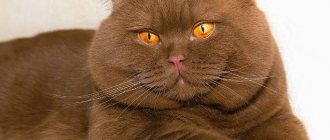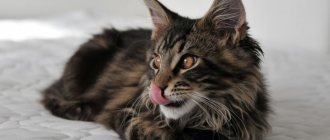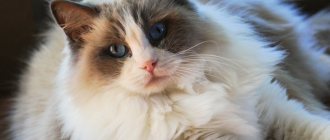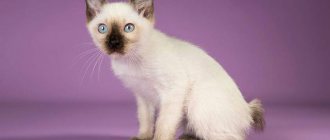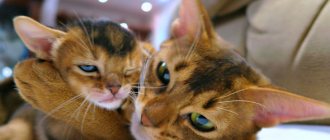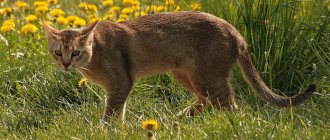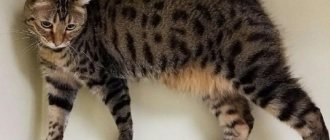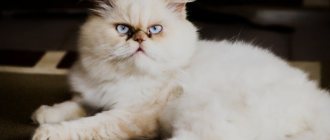Oriental cats are amazingly beautiful, although unusual in appearance, animals. The breed is closely related to the Siamese. It owes its popularity not only to its exotic, unforgettable appearance, but also to many positive character traits.
Plus, cats are naturally smart. Since there are short-haired and long-haired representatives, before adopting a kitten you need to find out all the details about care and maintenance.
Oriental cat white and gray
Origin story
The birthplace of Orientals is Thailand. First learned in the 13th century AD. e. They were mentioned in the ancient scripture about cats. For several centuries, the authorities imposed a ban on the export of these exotic cats outside the country. Therefore, in other states no one knew or even heard about them.
Oriental cats first appeared at a London show in 1894. But the contestants were disqualified. The judges decided that these were Siamese representatives with chestnut fur and green eyes. And this does not meet the standard. The same thing happened 2.5 years later at an exhibition in England.
Oriental
Active breeding of this breed began in the 50s. 20th century two ladies: Baroness Edith von Ullmann and Armithog Horgraves. Orientals owe their existence as individual representatives. The first kittens we got were chocolate colored. Then we managed to develop blue, beige and other colors.
Exotic appearance
Siamese were crossed with other breeds of suitable color - Russian Blue, Abyssinian. Outbred individuals with black fur were also involved in the process. Thanks to the emergence of a variety of colors, interest in Orientals increased and in 1977 they received official status as a separate breed.
Oriental cat health
Possible diseases
Oriental cats cannot be called the owners of good health. Despite the fact that on average they live 15-17 years, they are characterized by a number of diseases inherited from their Siamese ancestors.
The most common genetic disease among representatives of the breed is liver amyloidosis, which leads to liver failure, and in its neglected form, to the death of the pet. The symptoms of the disease are quite specific, but if activity weakens and appetite deteriorates, you should immediately contact a veterinary clinic for advice.
Problems with the functioning of the heart are caused by a disorder in the myocardium, this is the so-called dilated cardiomyopathy. Diagnostics using an ultrasound machine, which is done every six months of the oric’s life, will help prevent it.
Unusual, slightly slanted eyes can also cause unpleasant moments. In addition to inflammation and conjunctivitis, hereditary strabismus and retinal atrophy are possible.
Flat chest syndrome in newborn kittens leads to underdeveloped lungs and death from suffocation if the baby is not noticed and treated in time.
The large ears of an Asian cat are prone to otitis media and inflammation. If the problem is not dealt with in time, you can end up with an animal with hearing loss or complete hearing loss.
An incorrectly selected diet can lead to obesity or the development of food allergies in pets. Because of this, the state of health is impaired, and the appearance of the coat deteriorates, which becomes dull and begins to shed more.
Reproductive health
A cat becomes sexually mature by 1-1.5 years of age. At the same time, mating of seals and female cats of this breed is allowed. It is not worth doing this earlier, because the female’s body will not be completely ready to bear and give birth to healthy offspring. Cats that are too young produce non-viable or unhealthy litters.
Pregnancy and childbirth among Oriental women do not have any peculiarities unique to them. Like all felines, they may need human assistance during lambing. There can be 3-7 kittens in a litter.
Females and males become caring, responsible parents.
Females can be sterilized after a year of life, and boys can be castrated at the age of 6-7 months. The health of a cat directly depends not only on care, but also on timely sterilization - unless, of course, breeding is planned.
Description of the breed
A cat that looks like a Georgian
Oriental cats are not large, but they cannot be called small either. The Oriental cat is larger than cats. So, males weigh about 5-6 kg, females - 1.5 kg less. The height at the withers is 33-34 cm.
These representatives attract with their extreme oriental appearance, which cannot be confused with another. Once you see an oriental (at least in a photo), the memories will remain forever.
Breeders note their significant similarity with Siamese individuals. Requires maximum attention from the owners. At the same time, they are unpretentious in care. The important thing is that Orientals are hypoallergenic.
Who is not recommended to have an ori?
You should not have a pet of this breed if you:
- Do you plan for your pet to spend half the day alone while you are at work?
- You don’t have the strength, patience, desire and time to educate an Oriental.
- Don't like cats that are always nearby and prefer those who are on their own.
- You don't like talkative animals; loud noises irritate you, and you prefer peace and quiet.
- Spend part of your time on the road or move frequently.
Oriental breed standard
A cat with amazing grace
Description according to the international standard:
| Body parts | Characteristics |
| Torso | Narrow and elongated, with clearly visible muscles and thin bones. It is graceful, elegant, athletically fit. The tail is narrow, long, and resembles a whip. In some individuals its length reaches 90 cm. The chest protrudes, sometimes like a keel. The stomach is flat. |
| Neck | Elegant, visually fragile. |
| Head | Triangular in shape, flattened. It has a muzzle in the form of a triangle, with a narrowed chin. The nose is smooth and wide throughout. There is no clear transition between the lines of the nose and forehead. The profile is straight. |
| Eyes | Almond-shaped, large and very expressive. They have a certain bevel towards the ears along the outer tips. The color of the iris depends on the coat color: usually green or blue. |
| Ears | Large, triangular, out of proportion to the head. Widely spaced from each other. Taper slightly towards the tips. |
| Limbs | Slender, long, with compact rounded paws. The hind limbs are slightly longer than the forelimbs. |
| Wool | Short or long (depending on the representative), quite thick and fir-like to the touch. There is almost no undercoat. |
What is an extreme type of oriental
The extreme type includes cats that have the most pronounced pedigree external features:
- large, widely spaced ears;
- elongated muzzle;
- undefined angle between the forehead and the bridge of the nose;
- thin skeleton;
- short coat close to the skin.
Extreme kittens are more expensive than regular kittens. This is due to the fact that it is extremely difficult to obtain offspring of this type. Even the mating of two extreme individuals does not always produce a similar litter.
It is almost impossible to purchase an “extreme” kitten for breeding. Typically, breeders sell only pet-category cubs (companions), and breed-level kittens (suitable for breeding) are left to do the breeding themselves and exchange with other nurseries.
Despite the high cost, an extreme type kitten does not always belong to the show category. Moreover, exhibition experts have vague requirements for the appearance of Oriental cats: some, for example, require large and low-set ears, others do not allow such an external feature.
In general, any oriental extreme cats that do not have breed defects are sent to exhibitions.
Longhair Oriental
Long-haired Orientals were bred by Americans in the 1980s by crossing short-haired Orientals and Siamese. Most phenological associations and breeders have recognized them as a full breed.
Longhair
These beauties weigh about 6 kg. Common colors: tabby, smoky, shaded. Externally, Orientals with long hair are similar to Balinese, with the exception of coloring. By nature, extremely friendly and affectionate.
Cost of an extreme oriental kitten
The cost of an extreme type Oriental is determined by the exhibition category and coat color.
Since kittens in the breeding category are rare and have an ideal pedigree, they cost accordingly - from 100 thousand rubles. An Oriental companion kitten, not intended for breeding, will cost about 50 thousand.
The cheapest are kittens with minor defects that do not affect the quality of life. They will not participate in exhibitions, are not allowed to breed, but they become no less wonderful companions and family members, their cost is about 30 thousand rubles.
Shorthair Oriental breed
Short-haired handsome man
These representatives have a coat that fits tightly to the body, forming a thick coat. It shimmers when exposed to sunlight and when the animal moves. Due to the lack of undercoat, they can freeze at low ambient temperatures. Therefore, they must be protected from drafts. But they do not require special care, since the wool does not roll into tangles.
It is enough to comb them periodically, which additionally serves as a massage for the skin. This procedure brings pleasure to pets.
How to cope with loneliness
Orientals become strongly attached to their owner, and therefore his absence becomes very stressful. Long-term solitude or frequent absence of the owner due to work and other reasons can be a serious test for the pet. As a result, such a “Georgian cat” may not only end up in a state of severe stress, but also begin to get sick as a result of nervous exhaustion.
Colors
The most common color among Orientals is chocolate (Havana). Such cats have a rich tone throughout their body (even the tip of the nose), only the paws are noticeably lighter. Other popular colors:
- brindle;
- marble;
- ticked;
- tabby;
- blue;
- cinnamon (light brown);
- faun (beige);
- red (scarlet);
- lilac;
- black;
- white (rare).
beautiful color of the cat
Types and characteristics
The following types of color are distinguished, described in the table:
| Colors | Description |
| Ebony | Cats have shiny black fur |
| Blue | Gray-blue or black-blue color with tints |
| Grey | A cat with a soft tone that has a purple sheen |
| Chocolate | Exotic Siamese colors, chocolate-colored cats have green eyes |
| Marble | A rare subspecies, there are three black stripes on the back |
| An Oriental kitten with this color appears only from parents with the same color | |
| White | This color appeared recently, cats with blue eyes and shiny light hair |
| Tabby | Oriental cat with various spots and patterns on the body |
Character
Mischievous little ears
Orientals cannot be classified as calm pets who prefer to lounge on the sofa. They are extremely active and playful. restless creatures. They cannot live without everyone's attention. Therefore, sometimes they obsessively demand affection and care from their owners, regardless of whether they are busy or not.
Since they are tactile cats, they always try to sit on their owner’s lap. And if you pet your pet at the same time, then happiness will know no bounds.
"Talkative" beyond measure. Sometimes it seems that they are really saying something, only in their own language. Almost all actions performed are accompanied by various sounds: hissing, grunting, meowing. These cats also cannot be denied intelligence and intelligence. Therefore, they are easy to train.
Black orietal
Another character trait of Orientals is curiosity. They are interested in everything: what is happening outside the window, as well as in the house. They can sit on the windowsill for hours, watching the movement outside. Closed boxes and cabinets attract the most attention. No matter what it takes, they will definitely get in there and deal with the contents.
Touchiness is in the blood of these cats. This trait is inherited from the Siamese. If someone offends them, the pet will not react outwardly and will seem indifferent. Only internal experiences will not leave him for long.
Rare white color
Cats quickly become attached to the owner and all family members. Loneliness is difficult to bear and they are very bored when no one is home. They get along with other pets without problems if they grow up together from early childhood. They will not show aggression and rage, regardless of the circumstances.
Playfulness
An eared cat with a Georgian nose will happily run after a ball, bring toys to its owner like a dog, and simply play with a new thing. She is active and mobile, loves to explore everything, and there is not a place in the house where she will not climb, informing the owner about it. Sometimes she can purposefully hide and watch as people are looking for her, and then suddenly jump out, inviting her to play. It will be useful for the future owner of an ori to purchase a gaming complex for the pet in order to engage the pet in an activity without your participation.
Attitude towards children and family
Representatives of the breed cannot say that they love children very much, but they are tolerant of them. They will never use their claws, even with an unintentionally careless attitude towards themselves. However, little pranksters will not be allowed to invade their personal space.
Family
The only disadvantage of oriental cats is possible jealousy of the owner when he pays more attention to the children. Sometimes, the desire to always be the center of attention leads to certain difficulties in communicating with a cat.
Health and diseases
The breed is considered hardy, but there are diseases that are transmitted at the genetic level. A large number of cats are at risk of developing hypertrophic cardiomyopathy. Kittens can develop chest tightness, which negatively affects the functioning of the lungs and heart. Without treatment, this pathology can be fatal. Gingivitis, an inflammation of the gum tissue, is common. Therefore, it is advised to accustom your pet to brushing its teeth in order to prevent the occurrence of such a disease. If an Oriental cat is overweight and in poor health, amyloidosis may occur: without treatment, the pathology leads to the death of the animal. In rare cases, retinal atrophy occurs, which leads to complete loss of vision.
Care and maintenance
Happiness in the home
Orientals are not demanding in terms of care. They themselves are clean. So the tray will have to be cleaned in a timely manner so that the pet does not refuse to go into it. Basic hygiene procedures include:
- Swimming when dirty. Animals are not afraid of water if they are accustomed to bathing procedures from an early age. It is recommended to dry the fur with a hairdryer so that the cat does not have time to get wet.
- Cleaning ears and eyes. Remove dirt from sinks and eyes with a cotton pad soaked in boiled water. It is enough to do this twice a week.
- Trimming nails. This is done with a special tool (sold in a pet store).
- Dental treatment. The procedure prevents the formation of plaque and tartar. It is advisable to have your cat's teeth cleaned by a veterinarian once a year.
You don't need a lot of space to keep orientals. They feel comfortable in cramped conditions. But without toys they can get bored because they lead an active life. You should definitely purchase a scratching post to prevent damage to the furniture.
marbled wool color
Upbringing
Adult Oriental cats have a hard time getting used to new neighbors - other pets in the house. If you get someone else, you need to do it while the kitten is small. The baby’s adaptation to a new place occurs quickly. The main thing is to pay more attention to him and surround him with care.
Any educational measures must take place without physical violence. There is no need to rush, but to instill proper manners in your pet consistently and slowly. You can’t swear and punish if something doesn’t work out for the baby. It is often problematic to train a pet to relieve itself in a tray. So you need to be patient.
Strongly attached to the owner
Wool
The coat will be shiny and healthy if you brush it several times a week. It is better to use a rubber brush or a special glove.
Nutrition
But you need to be scrupulous about your diet. Orientals have a digestive system designed in such a way that it is difficult to digest the host’s food. They should be fed prepared dry food or canned food. You can alternate, but you cannot mix or give at once. Sometimes it is permissible to pamper your pet with some delicacies:
- raw meat;
- milk porridge;
- fish without bones.
Giving such delicacies too often is harmful. Firstly, they discourage the desire to eat industrial food, and secondly, they lead to obesity. Additionally, vitamin and mineral complexes are included in the diet. They are sold in veterinary pharmacies.
Smart cat
Walk
They are true homebodies and do not need walks in the fresh air. Due to the lack of undercoat, animals are constantly cold, so in winter they will definitely catch a cold outside. In the summer, if the weather is good, you can take a walk with your pet. Just be sure to put on a leash, otherwise the animal’s excessive curiosity can distance it from home.
Features of feeding and diet
The best food option for Oriental cats is high-quality industrial food. The weak, imperfect gastrointestinal tract system of Orientals will not be able to completely digest food from the host’s table, which can cause allergies and disturbances in the functioning of the stomach and intestines.
The owner of the eared cat must decide what food to feed it. You can consider options with dry or wet food, and also alternate between these two types of food. It is important not to mix both types of food in one feeding.
An attentive owner will determine by the appearance of the Oriental what suits him best. The condition of the coat is a direct indicator of the health of the pet's digestive system. With the right type of food and sufficient saturation with vitamins and minerals, your pet’s coat will be soft and silky. The presence of dandruff or brittle hair indicates serious problems with the cat's diet.
To diversify the menu and pamper the Asian, he is given natural products. It can be:
- boiled pieces of lean meat;
- boneless sea fish fillet;
- oatmeal with milk without added sugar.
Often the above-mentioned goodies should not be offered, since the pet can quickly get used to them and then refuse the industrial food that is familiar to it. The second problem is obesity, to which oriki often suffer.
Make sure your pet doesn't overeat. The amount of food in the bowl should correspond to his needs: if there is excess food left, the portion must be reduced.
You can feed kittens according to a strict schedule, starting from a month of age. But adult individuals perceive such fragmented feeding as a hunger strike and begin to stock up on food for future use.
From 1 month of age, animals’ food is enriched with mineral and vitamin supplements. You won't have to do this when feeding premium or higher dry foods. They already contain all the nutrients necessary for a cat’s health.
The constant presence of clean water in the bowl will ensure good functioning of the Oriental's digestive organs.
How to choose a kitten
A cute creature that looks like a cartoon character.
You should buy an Oriental kitten in specialized nurseries or from trusted breeders. Only there will they be able to provide all the documents confirming their belonging to the breed.
You should not separate your baby from the mother cat before the age of three months. By this time, they become independent and will not experience separation so acutely. It is preferable to choose in person. In this case, pay attention to the following indicators:
- the coat should be clean, shiny, shiny;
- Dirty discharge from the eyes, nose, and under the tail is unacceptable;
- the kitten should be active and not angry.
You definitely need to meet your parents and learn everything about your ancestors.
The cost of a kitten of this breed depends on the purebred pedigree and achievements. The price usually varies from 20 to 100 thousand rubles. The most expensive representatives are those that belong to the show class. They are intended for exhibition display and reproduction.
Tips for choosing a kitten
When purchasing a representative of the Oriental breed, you should consider a number of features:
- do not purchase a pet younger than 3 months;
- check documents to confirm pedigree;
- look at the veterinary passport for information on scheduled vaccinations;
- ask to see the conditions of keeping the future pet;
- pay attention to the exterior of the pet’s parents;
- inquire about the type of feeding of the animal.
When making a choice, observe the kitten's behavior. If he was kept with other individuals, then problems with long-term socialization should not arise. But babies kept in cages will be more wild, so it may take longer to raise them.
The kitten's eyes and ears should be clean, without signs of inflammation. The fur of healthy animals is soft and silky, without tangles or bald spots. All Oriental kittens should look good, lively and not cause discomfort.
Breeding
Caring mother
To obtain offspring, you need to find a suitable representative. All applicants must undergo a thorough selection based on the following parameters: state of health, purity of pedigree, availability of all vaccinations. In such a situation, it is better to contact a nursery, where there is a better chance of finding a purebred cat of this breed.
It is advisable to knit no more than once a year. It is better to start not from the moment when the first heat occurs, but after 2-3. If you want to get kittens of the highest quality, you need to select a partner of the same type. But even then there is no 100% guarantee of the birth of ideal babies.
Pregnancy lasts from 59 to 70 days. During this period, the animal does not need special care, except for expanding the diet. It is advisable to feed the expectant mother with special foods for pregnant women, which contain many vitamins and minerals. The belly becomes noticeable from the 5th week, and preparations for the upcoming birth begin from the 8th week.
They prepare a secluded but comfortable place for the woman in labor, away from public view. There are from 3 to 5 kittens in one litter.
Are Oriental cats hypoallergenic or not? How often do they shed?
Orientals can be called practically hypoallergenic, since their protein (which provokes allergies in humans) is synthesized to a lesser extent than in other breeds.
Shedding in eastern cats is moderate, and therefore does not cause any special problems. With proper care of the coat and sufficiently humidified air in the house, shedding will occur only in the autumn and spring seasons. At this time, the owner will need to increase the frequency of brushing the pet to several times a week.
Advantages and disadvantages
Oriental cats, like any other breed, have their positive and negative sides. You should know them before you decide:
| pros | Minuses |
| · exotic appearance; · agile, mischievous and incredibly graceful; · attractive large ears; · smart and quick-witted; · can intuitively understand the owner’s mood and adapt; · sociable, friendly; · strongly attached to the owner; · do not require complex care and comfort; · not predisposed to genetic diseases; · do not cause allergies in people. | · overly touchy; · too dependent on the mood and behavior of the owner; · need constant attention; · cannot stand loneliness; · catch cold quickly even from the slightest draft. |
Vaccinations and antiparasitic treatment
To protect the Oriental from viral diseases, it is systematically vaccinated with a complex drug that produces immunity:
- to panleukopenia;
- rhinotracheitis;
- calcivirus.
The first vaccination is given at the age of 7-8 weeks. After 4 weeks, the kitten is vaccinated against the same diseases and rabies. Subsequently, the oriental is vaccinated once a year.
To prevent diseases carried by parasites, the cat is regularly treated for fleas and worms. Anthelmintic drugs are given to the Oriental 2 times a year with mandatory repetition after 10-14 days.
A cat of this breed is treated against fleas with drops or shampoos. And if she regularly goes outside, she is additionally protected with an anti-parasitic collar.
Interesting Facts
not only interesting in appearance.
Oriental breed cats are interesting in many respects. Here are some fun facts about them:
- popularly called “rainbow” due to the variety of colors;
- Orientals are almost the only representatives of cats who do not have genetic pathologies;
- these are long-livers, since their lifespan can reach 20 years;
- before official registration, Orientals were called “one-color coffee Siamese”;
- oriental cats need constant tactile contact with their owners and active games, otherwise they begin to meow loudly;
- jealous of their owner's attention to other people and even objects;
- Orientals never release their claws, so it is safe to leave children with them;
- cats show devotion, characteristic only of dogs;
- They are popularly called “talkers” due to their inability to remain silent for even a few minutes.
Catering
The main requirement for food is its balance.
Recommended food
If you are a busy person, then it will be easier to feed your pet with industrial ready-made food. They are conventionally divided into 4 groups: holistic, super premium food, premium food and economy class.
Holistics
Holistics are more expensive than others, but they are also better in composition. They do not use synthetic preservatives, wheat flour, corn, or vegetable protein ingredients. Contains only the best: fresh and dehydrated fish fillets, meat; peas, rice and lentils as sources of protein, and dried vegetables and fruits as sources of fibre. In addition to the above, there are also vitamin and mineral supplements. Examples of holistic feeds: AATU, Farmina N&D, Now Fresh.
Super premium class
Super premium food is somewhat lower in quality and the price of the product is noticeably lower. Ingredients: a good vitamin and mineral supplement, natural preservatives, while the percentage of meat ingredients is lower, as well as fewer sources of carbohydrates. Examples: Leonardo, Duke's Farm, Pronature Original.
Premium
Advantages of premium food: natural additives; low price; more meat than in cheap analogues; There is food for both kittens and adult cats, as well as for animals with diseases. Disadvantages: rather low meat content; a large proportion of plant components; the presence of dyes and flavors. Examples: Brit Premium, Royal Canin, Pro Plan.
Economy
Economy line food is bought by people who either cannot allocate a certain amount to feed a cat, or who do not know the truth about them. Their only advantage is their low price, but there are many more disadvantages! Firstly, the basis is corn and cereals, and exact descriptions and percentages are not indicated. Secondly, dyes and flavor enhancers are used. And finally, thirdly, these foods are poor in protein.
Below are recommended premium and holistic foods; links with food names are clickable. Using them, you can, within our website, read descriptions of food and read reviews from owners of the Oriental cat breed.
| Super premium | Premium | Holistic |
| Meowing Heads | Science Plan | Carnilove |
Natural products
If your choice is natural nutrition, consider the following.
Orientals love to eat, but are prone to being overweight. The permissible daily calorie intake for cats is 300 kcal, for females – 250 kcal. Babies up to 2 months are fed at least 5 times a day, from 2 to 4 months - 4 times, from 4-6 months - 3 times, over six months - in the morning and in the evening. Food should be at a comfortable temperature: not hot, but not from the refrigerator.
Be sure to include in your diet:
- Beef, lamb or rabbit: 3-4 times a week, 100-120 g;
- Chicken meat: every day;
- By-products (stomachs, heart, liver, chicken necks), minced: 1-3 times a week;
- Fish (trout, cod, salmon, hake, salmon): once a week for cats and 1-2 times for cats;
- Milk (boiled): for kittens up to 3 months, pregnant and lactating cats;
- Egg yolk, whole quail egg: 2 times a week.
- Porridge (rice, oatmeal, buckwheat, wheat): daily;
- Liquid semolina porridge - for kittens up to 3 months;
- Fermented milk products (low-fat cream, cottage cheese, sour cream, natural yogurt, kefir): possible every day;
- Cheese (unsalted): once a week;
- Boiled or fresh vegetables (beets, carrots, cauliflower, cucumbers, green beans): 4-5 days a week;
- Sprouted wheat grains, spinach, salad: 2 times a week;
- Brewer's yeast (dry): 3-4 times a week;
- Vegetable oil (half a teaspoon per porridge): every other day;
- Special supplements with vitamins and minerals: as recommended by a veterinarian.
The cat should always have access to fresh and clean drinking water. Do not pour tap water that is cold or contaminated. Change the liquid 2 times a day: morning and evening.
Oriental cats should not be given:
- Pork, lamb, duck and geese meat;
- Chicken bones, fish bones;
- Sweets: chocolate, marmalade, marshmallows, honey, cakes, etc.;
- Salt, spices, sauces;
- Baked goods (bread, cakes, pastries, etc.); human canned food and sausages;
- Smoked, salty, sweet dishes;
- Potatoes, soybeans, beans (with the exception of asparagus); human vitamins and supplements.
Photo of an oriental breed cat during rest hours)
Myths and real facts
There is an opinion that oriental cats make unpleasant sounds. This happens, but rarely. It depends on the nature of the animal and the attitude of the household towards it. If the pet is on friendly terms with the owner and all family members, then the cat will not be excessively intrusive and loud.
Another myth is that Orientals like to climb curtains. In fact, only kittens do this. Having matured, they become well-mannered and do not cause damage to the interior.
An Oriental cat can become a truly loyal friend and companion for the rest of its life. With proper care, they will easily celebrate their twenty-year anniversary. At the same time, they remain just as active, funny and playful, which is confirmed by numerous reviews from the owners.
Training and education
Walking an oriental cat on a leash
Orientals inherited from their Thai ancestors a lively, sharp mind and excellent learning abilities. In particular, it is easy to “train” a cat to fetch objects, as well as to carry out simple commands. As for the basics of etiquette, their pet will have to be instilled, because, despite the fairly high level of intelligence, oriental cats are capable of minor dirty tricks. For example, little eared cats love to swing on curtains and dig into flower pots. They do this not out of harm, but out of thoughtlessness, so it is very important to immediately point out to the kitten that such behavior is unacceptable.
Punishing, let alone beating, an animal is the last thing. An Oriental cat can easily guess about its own mistakes, relying only on the intonation of your voice, so use this quality to its full potential. Sternly shout at the mustachioed lawless man walking around the table and hiss expressively at the kitten climbing the curtains. You can be sure that the pet will intuitively understand what they want from him.
A common mistake that can negate the results of all your efforts is periodic exceptions to the established rules. As an example: today a serious reprimand has been given to the kitten jumping on the table, and tomorrow you are filming a video for YouTube where the tiny Cheburashka is briskly climbing the tablecloth to your encouraging comments.
Diseases
This breed is considered relatively healthy, but Orientals are predisposed to the following diseases:
Cardiomyopathy is a group of non-inflammatory heart diseases. The disease can occur unnoticed by the owners and “come out” only in a stressful (for the animal) situation. The animal develops shortness of breath, vomiting, prolonged weakness, and a drop in temperature. The cause of the disease is not fully understood. Treatment: ACE inhibitors, diuretic, calcium channel blocker. Prevention: high-taurine diet, minimum fat and salt in food, weight control.
Gingivitis is inflammation of the gums around one or more teeth. The cause may be untreated caries, plaque, nutritional deficiencies, viruses, infections, or radiation. The animal's gums turn red, and when pressure is applied to the gums, blood appears. The cat becomes lethargic and irritable and refuses to eat. Her mouth stinks. In severe cases, taking medications, treating the mouth with a disinfectant solution, using ultrasound, or removing a tooth will help.
Liver amyloidosis is a hereditary disease associated with impaired protein metabolism. Mostly older animals (over 7 years old) are affected, but sometimes the disease is also diagnosed in children. Females get sick 2 times more often than males. The cat begins to vomit from time to time, she runs to urinate in the tray more often and drinks a lot, stops eating, and loses weight. Edema and ascites appear. The animal is put on a low-protein diet, and drugs that relieve intoxication are infused into the veins.
Expert opinion
Dusheba Vera Ivanovna
In 2010, she graduated from the Moscow State Academy of Veterinary Medicine named after K.I. Scriabin with honors, specializing in veterinary medicine. I regularly attend veterinary conferences, congresses, and webinars.
Kittens, no matter how smart they are, chew everything indiscriminately. Therefore, make your home as safe as possible: hide chemicals and fragile things, sharp and small objects, secure wires higher (or hide under baseboards). Remove houseplants that pose a danger to them (for example, Dieffenbachia) out of sight. Cover the windows with strong nets to prevent the cat from falling out (mosquito nets will not work!).

